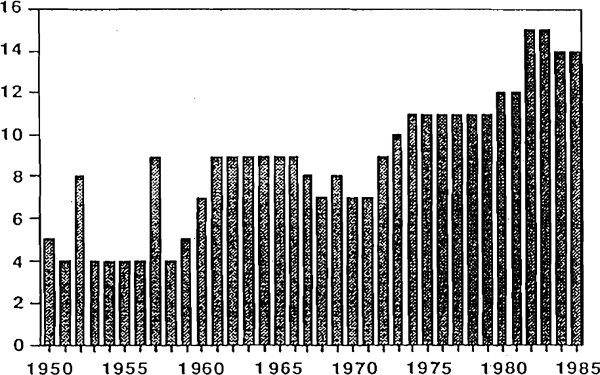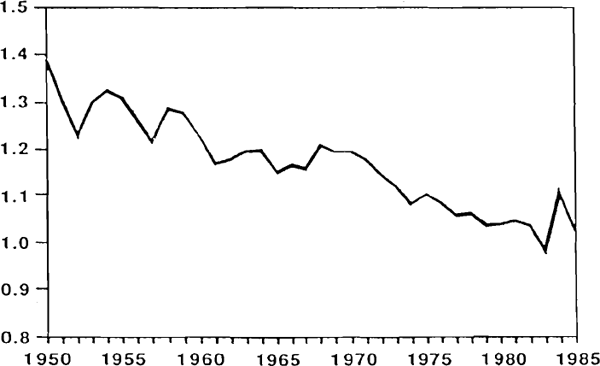RDP 9201: The Impact of Real and Nominal Shocks on Australian Real Exchange Rates 1. Introduction
January 1992
- Download the Paper 635KB
There is a vast literature examining the Purchasing Power Parity (PPP) hypothesis.[1] The latest battery of tests centre on testing for a unit root in real exchange rates. Essentially, these tests ask the following question: should a positive innovation in the real exchange rate today lead one to revise upward one's forecast for all future horizons? The answer to this question must surely be it depends. Specifically, it depends upon the nature of the shock. Most models of exchange rate determination predict that a monetary shock will have no long run effect on the real exchange rate, although sticky prices may result in some short run effect. In contrast, models of exchange rate determination which are equipped to analyse the impact of structural shocks, predict that such factors as changes in relative productivities can permanently alter real exchange rates.
Theory clearly suggests that the nature of the real exchange rate response depends critically upon the type the shock. The real exchange rate will, however, exhibit a unit root if there are any shocks with permanent effects. Thus, while the finding that a unit root exists is informative, it provides no evidence on the relative importance of the permanent shocks. One way to examine this issue is to explicitly allow for shocks from different sources. This is the approach taken in this paper. A standard model of exchange rate determination is used to provide the restrictions needed to identify the two types of shocks most frequently discussed in models of the real exchange rate, namely real and monetary shocks. This approach helps provide answers to two questions of interest. First, how important are real versus monetary shocks in deviations from PPP? Second, how does price sluggishness influence real exchange rate and unemployment dynamics in response to real and monetary shocks.
Huizinga (1987) in a study of real exchange rates finds a degree of mean reversion in most bilateral real rates. In a world characterised by both real and monetary shocks such a pattern might well be expected. In related work, Mark (1990) examines deviations from PPP for a range of currencies and concludes that Keynesian models suggest that shocks to real exchange rates are due principally to exogenous shifts in aggregate demand, while equilibrium models suggest that monetary factors have been more important. Daniel (1986) finds important roles for both price stickiness and real shocks in real exchange rate changes. These studies do not explicitly identify the various shocks with theoretically derived restrictions, nor do they examine the relative importance of the various shocks at different forecast horizons.
The paper begins with an examination of the long run. In doing so, questions concerning monetary factors and the extent of short-run wage and price flexibility recede into the background with real shocks providing the principal explanation for changes in real exchange rates. Provided prices and wages are flexible in the long run most models predict long-run monetary neutrality. They also predict that both monetary and real shocks have no long-term effect on the unemployment rate. In contrast, in the short run, price rigidities play a potentially important role in exchange rate and unemployment dynamics in response to both types of shocks.
The analysis is focused on Australian dollar real exchange rates. They provide a particularly interesting case to study. Since the Second World War Australia's terms of trade have shown secular decline and have been significantly more volatile than those of most other OECD nations. Australia's productivity performance, measured by growth in per-capita income, has also been poor relative to that of other members of the OECD. Graph 1(a) shows Australia's rank amongst 22 OECD nations in terms of Summers and Heston's (1988) internationally comparable measures of income per capita. Australia's income per capita relative to that of the average of 22 other OECD countries is shown in Graph 1(b). Australia's performance has clearly been inferior to that of the OECD as a whole. In 1950 its per capita income was 5th highest in the world. By 1985 it had fallen to 14th highest. Gruen (1986) using Summers and Heston's data up until 1977 suggested that Australia's relative decline may have slowed by the mid 1970s. The results in these graphs suggest that this has not been the case. Gruen identifies low rates of capital formation, product and labour market rigidities, protection from world markets and rent seeking by the major actors in the economy as principal causes of this poor productivity performance.


While recent studies on longer-run changes in Australia's real exchange rate have focussed on the terms of trade (McKenzie (1986) and Blundell-Wignall and Gregory (1990)) little attention has been given to the importance of this relatively poor productivity performance. Relative productivity decline is more gradual than the sometimes sudden and dramatic changes in the terms of trade. This more gradual change makes its role in real exchange determination less immediately apparent, yet models of the real exchange rate suggest that it is an important factor. Empirical work by Hsieh (1982) shows that changes in Japanese and German real exchange rates are well described by a simple relative productivities model. More recently, work by Marston (1990) and Bergstrand (1991) also supports the relative productivities model. Section 2 examines Australian dollar real exchange rates and Australia's relative productivity performance over the period from 1970 to 1990. The focus is on the Australian dollar/US dollar (AUD/USD) and the Australian dollar/Japanese yen (AUD/YEN) exchange rates.
In the following section attention turns to shorter-run exchange rate dynamics. The joint behaviour of the real exchange rate and unemployment rates is used, together with long-run restrictions on the effect of various shocks, to examine the relative importance of these shocks in deviations from PPP in both the short run and the long run. The approach is adopted from Blanchard and Quah (1989). They examine the relative importance of supply and demand shocks in USA real GDP and unemployment dynamics.
Shocks from three sources are identified. All three shocks are assumed to be uncorrelated and to have no long-run effect on either countries' unemployment rate. The first shock is permitted to alter permanently the real bilateral exchange rate. The second and third types of shocks are, however, not permitted to have any long-run impact on the real exchange rate. As in Blanchard and Quah (1989) the shocks are defined by the identification restrictions imposed, but using the exchange rate determination model in Mussa (1984), each has an economic meaning. The two disturbances that are not permitted to alter the real exchange rate can be thought of as nominal shocks, one originating in each country. The shock which is allowed to alter permanently the real bilateral exchange rate can be interpreted as a real shock, say a shock to relative productivities or to the terms of trade. Section 3 of the paper discusses the identification of each of the three shocks. This is followed in Section 4 by the presentation of the results. Finally, Section 5 concludes and summarises.
Footnote
See Dornbusch (1988) for a comprehensive review of the Purchasing Power Parity literature. [1]